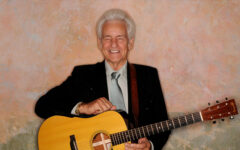
2019 Hall of Fame inductee Bill Emerson has been a bluegrass music icon for over 60 years. His youngest son Billy doesn’t have such a storied history – and that, until now, has been as the frontman of a hybrid “rockgrass” band for 10 years. For the first time father and son have recorded together, the product being a four-track EP – Emerson 414 – the latter’s introduction as a bluegrass/Americana recording artist.
Emerson senior (formally William H. Emerson Jr.) is well-known for his ear for music outside the bluegrass norm at the time, having introduced a British pop song, Fox On The Run, to the bluegrass music repertoire and, with The Country Gentlemen and the group Emerson & Waldron, helped to popularize bluegrass music in the sophisticated Washington DC market starting in the 1950s.
Son Billy (William H. Emerson III) grew up in much of that environment, also witnessing at the family home, #414, since 1967 activities such as the formation of Emerson & Waldron, rehearsals by the second classic line-up of The Country Gentlemen, jam and recording sessions, and the meeting place for dozens of bluegrass music stars.
For Emerson 414 the Emersons have drawn on a spectrum of North American roots genres and styles
Beginning with a song penned by Lee Watson (of The Breakmen, a Canadiana and Indie Folk band from Vancouver); Leaving California, a “mid-tempo country ballad that tells of the broken dreams of a down-and-out yet resilient musician.” That is followed by the love song A Face in the Crowd – written by rock music icons Tom Petty and Jeff Lynne – and Jay Farrar’s (Son Volt, the American alternative rock and alternative country band) Tear Stained Eye. The last is Bruce Springsteen’s Stolen Car, described as “an inner-directed, psychological song that deals with a failing marriage.”
Bill Emerson offers some reasoning for this EP ….
“Emerson 414 was an opportunity to join my son Billy in recording some of the music he enjoys. While the songs aren’t quite traditional bluegrass, they’re true to life and fun to play.”
While Billy shares these thoughts about the song selection …..
“I brought all four of the songs to my dad and he agreed that they would all work. I’ve always liked Springsteen and Petty. My recent band mates turned me on to Son Volt, and I came across Leaving California listening to Pandora (it was the first song I brought to him). Dad feels that Leaving California might be the strongest as a single, but we think they are all really good and unique. I don’t think any have been recorded as bluegrass versions before. Along with Dad’s song-writing talents, etc …He is a MASTER when it comes to re-arranging songs. I think a little of that rubbed off on me over the years and factored in when I chose the songs. We co-produced each recording.
I must say he helped arrange them perfectly IMO for the way we recorded them.”
Billy Emerson sings lead on all the songs, playing guitar on Tear Stained Eye as well as Stolen Car; and Bill Emerson plays on banjo throughout. The other musicians are Tom Adams (guitar), Teri Chism (upright bass and vocals) and Wayne Lanham (mandolin, fiddle and vocals), all members of Bill Emerson’s Sweet Dixie band.
Emerson 414 (AcoustiGrass Records 012660-001) will be released worldwide on all streaming formats on Friday, August 2, 2019.
At the same time hard copies of the CD will be available from CDBaby and from Bill Emerson’s website.







